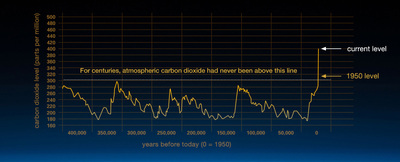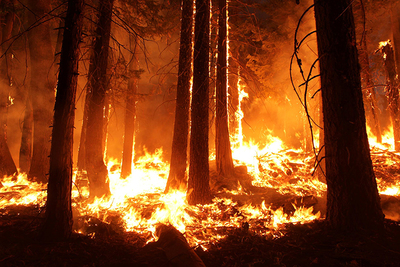Causes of Climate Change
List of Causes
There are multiple causes of climate change. Some are natural and some are caused by human activities.
- Greenhouse Gases
- Deforestation
- Desertification
- Solar Irradiance
- Atmospheric Aerosols
- Climate Oscillations
- Earth Orbit Variations
Greenhouse Gases

Historic Carbon Dioxide Levels
NASA Global Climate Change
The Earth's atmosphere has varied in its level of CO2 over the past 650,000 years, as shown in the above graph. The cyclical nature of that variation roughly coincides with ice age cycles during that time. However, at no time during that period did CO2 concentrations in the atmosphere reach the levels that we see today, which are in the range of 410 parts per million (PPM). Nor did the any of the variations in CO2 occur in such abrupt ways as seen in the present time.
There is no other way to explain this abrupt and very high difference in CO2 concentration than by the burning of fossil fuels.
Furthermore, carbon dioxide is not the only greenhouse gas. Methane, nitrous oxide, ozone, water vapor, and many synthetic compounds also contribute to global warming when released into the atmosphere.
Deforestation

Forest Fire
NASA Global Climate Change Blog
Deforestation is the mass destruction of trees and associated plant life, either by natural causes or human action. As a source of carbon dioxide in the modern global atmosphere, deforestation is potentially very significant and can contribute a lot to global warming.
The following are ways in which deforestation occurs:
- Natural or man-made forest fires
- Massive clearing of land for agriculture
- Ranching of livestock without environmental caution
- Indiscriminate logging for timber
When deforestation takes place, trees and other plants are either burned or cut down and allowed to decay, emitting carbon dioxide in the process. Deforestation accounts for a significant amount of current anthropogenic carbon dioxide emissions.
Desertification
Solar Irradiance
The sun varies in its emission of light, and the Earth varies in its distance from the sun. Those variations have contributed in the ancient past to variations in the Earth's climate. However, measurements of the solar energy from the sun since 1750 has remained constant or increased only slightly. The sun's changes in radiance are insufficient to explain the degree of change in the Earth's temperature over the period since 1750, the time when CO2 concentrations in the atmosphere started to increase.
In addition, if the sun's radiance was the cause of the Earth's increasing temperature, climatologists would expect that the atmosphere would be warming in all its layers. However, the only significant atmospheric warming is occurring at the atmosphere's lowest layer, the troposphere. That can only be explained by the greenhouse effect, in which CO2 and other gases capture heat radiated by the Earth and re-radiate it back down toward the ground.
Atmospheric Aerosols
Aerosols are tiny particles suspended in the atmosphere. They can scatter sunlight back into space, thereby reducing the amount of radiation from the sun that gets to the Earth. In this way aerosols act to cool the Earth and thus, to some extent, counteract global warming by greenhouse gases. However, the lifetime of aerosols in the atmosphere is very short, compared to greenhouse gases like CO2.
Aerosols can modify the size of cloud particles, which changes how clouds reflect or absorb sunlight. This effect has significant influence on the Earth's energy budget and can positively or negatively affect global warming.
Following are some of the principle ways in which aerosols are generated:
- Industrial burning of coal and oil
- Burning of trees in deforestation
- Volcanic eruptions
- Desert dust storms
Climate Oscillations
Climate oscillations are periodic, irregular, cyclic changes in the Earth's oceans and atmosphere that impact climate. These oscillations occur in many different time frames, from decades to centuries to millennia. A prime example of a climate oscillation is the combined "El Nino" and "La Nina" cycles that occur in approximately 7 year cycles in the tropical eastern Pacific Ocean. Together, these cycles are known as the "El Nino Southern Oscillation" or ENSO.
The ENSO phenomenon begins with atmospheric pressure changes over the eastern Pacific Ocean. These changes alter the ocean surface temperature and affect the upwelling of water from deep levels of the ocean. The results are shifts in ocean currents and atmospheric winds that can cause climate changes over the entire globe, ranging from upwelling of oceanic nutrients on which fish and other biota feed, to droughts or flooding in Asia, Europe, Africa or the Americas.
Although ENSO and other natural climate oscillations are significant in determining the weather in many areas of the Earth, they are not constant over time; their intensity is not sufficiently strong; nor is their territorial extent sufficiently global to account for the widespread effects and growing intensity of modern global climate change.
The introduction of massive amounts of greenhouse gases into the atmosphere is the only scientifically validated way to explain modern global climate change.
Earth Orbit Variations
Earth's orbit around the sun is slightly elliptical. The Earth is tilted and wobbles as it rotates. The Earth's degree of tilt changes slightly over thousands of years. All these phenomena have an influence on the Earth's climate and can be used to explain periodic glacial cycles, as well as very warm periods in the Earth's long history.
However, the time required for climate shifts due to orbital variations is measured in thousands to hundreds of thousands of years. Such orbital changes cannot be used to explain the changes in the Earth's climate that have occurred during the last few decades or even over the last couple of centuries. The only way to explain those climate changes is the massive amounts of greenhouse gases released by the burning of fossil fuels and by the deforestation of the Earth's land areas. The timing of the release of those greenhouse gases and the observed changes in the Earth's climate are virtually simultaneous, particularly when considered in the time frame of geologic history.